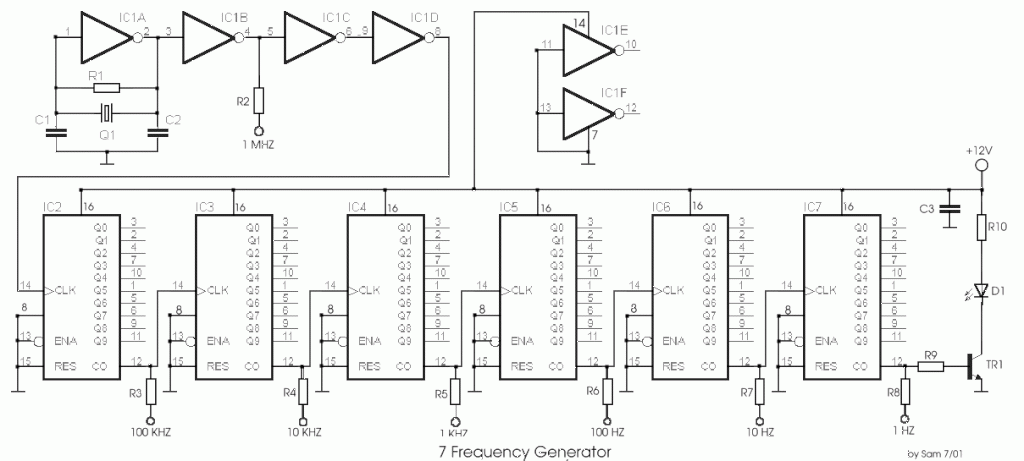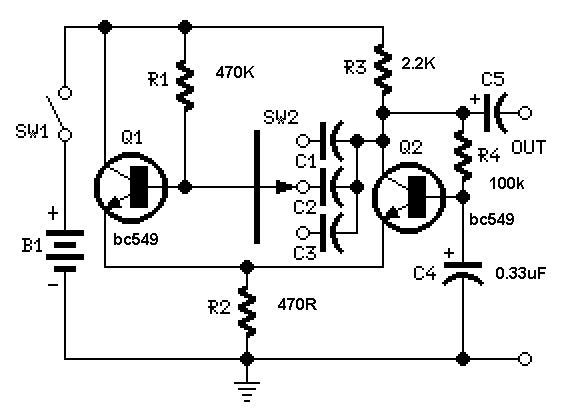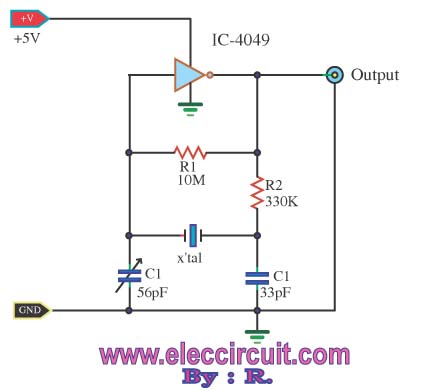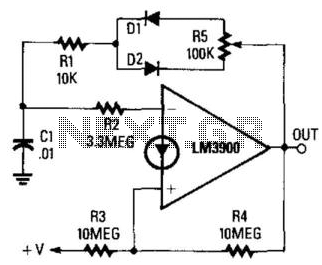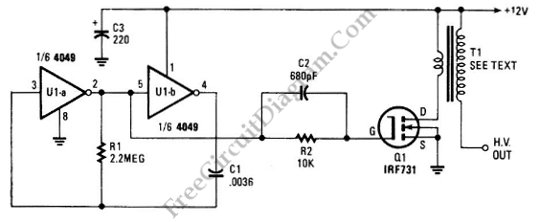
Musical Envelope Generator And Modulator

A gate voltage is applied to initiate the process. When the gate voltage is in the ON state, Q1 is activated, and capacitor C is charged through the attack potentiometer in series with the 1 kΩ resistor. By adjusting this potentiometer, the attack time constant can be modified. A rapid attack produces a percussive sound, while a slower attack creates the effect of "backward" sounds. When the gate voltage returns to the OFF state, Q2 is activated, and the capacitor discharges through the decay potentiometer and the other 1 kΩ resistor to ground. Consequently, the decay time constant of the envelope is also adjustable. This envelope is buffered by IC1, a high-impedance voltage follower, and is applied to Q3, which functions as a transistor chopper. A musical tone in the form of a square wave is connected to the base of Q3, turning the transistor on or off. Thus, the envelope is chopped at regular intervals determined by the pitch of the square wave. The resulting waveform possesses the amplitude of the envelope and the harmonic structure of the square wave. IC2 operates as a virtual earth amplifier to buffer the signal, and D1 ensures that the envelope fades away at the end of a note.
The circuit described utilizes a voltage-controlled envelope generator that modulates the amplitude of a musical tone based on the gate voltage applied to the system. The initial activation of the circuit occurs with the application of a gate voltage, which determines the state of Q1. When Q1 is turned on, it allows current to flow and charge capacitor C. The attack potentiometer, in conjunction with a 1 kΩ resistor, forms an RC time constant that dictates how quickly the capacitor charges. The adjustment of the attack potentiometer enables the user to create varied sound effects, ranging from sharp, percussive sounds with a fast attack to smoother, "backward" sounds with a slower attack.
Upon the removal of the gate voltage, Q2 is activated, allowing capacitor C to discharge through the decay potentiometer and another 1 kΩ resistor, which also contributes to the decay time constant. This decay time constant is adjustable, providing further control over the sound envelope. The buffered envelope signal, facilitated by IC1, is then fed into Q3, which acts as a chopper that modulates the envelope in alignment with an incoming square wave signal at its base. The square wave's frequency dictates the intervals at which the envelope is "chopped," resulting in a waveform that combines the envelope's amplitude characteristics with the harmonic content of the square wave.
IC2 functions as a virtual earth amplifier, ensuring that the signal remains stable and properly buffered throughout the circuit. Diode D1 plays a crucial role by allowing the envelope to decay gracefully, preventing abrupt cutoffs that could result in undesirable artifacts in the audio output. This configuration provides a versatile envelope shaping mechanism suitable for various audio applications, allowing for dynamic control over sound synthesis and modulation. A gate voltage is applied to initiate the proceedings. When the gate voltage is in the ON state, Q l is turned on, and capacitor C is charged up via the attack pot in series with the l-kfl resistor. By varying this pot, the attack time constant can be manipulated. A fast attack gives a percussive sound, a slow attack gives the effect of "backward" sounds. When the gate voltage returns to its OFF state, Q2 is turned on and the capacitor is then discharged via the decay pot and the other 1-KOhmhm resistor to ground. Thus, the decay time constant of the envelope is also variable. This envelope is buffered by IC1, a high-impedance voltage follower and is applied to Q3, which is being used as a transistor chopper.
A musical tone in the form of a square wave is connected to the base of Q3. This turns the transistor on or off. Thus, the envelope is chopped up at regular intervals, which are determined by the pitch of the square wave. The resultant waveform has the amplitude of the envelope and the harmonic structure of the square wave.
IC2 is used as a virtual earth amplifier to buffer the signal and D1 ensures that the envelope dies away at the end of a note.
The circuit described utilizes a voltage-controlled envelope generator that modulates the amplitude of a musical tone based on the gate voltage applied to the system. The initial activation of the circuit occurs with the application of a gate voltage, which determines the state of Q1. When Q1 is turned on, it allows current to flow and charge capacitor C. The attack potentiometer, in conjunction with a 1 kΩ resistor, forms an RC time constant that dictates how quickly the capacitor charges. The adjustment of the attack potentiometer enables the user to create varied sound effects, ranging from sharp, percussive sounds with a fast attack to smoother, "backward" sounds with a slower attack.
Upon the removal of the gate voltage, Q2 is activated, allowing capacitor C to discharge through the decay potentiometer and another 1 kΩ resistor, which also contributes to the decay time constant. This decay time constant is adjustable, providing further control over the sound envelope. The buffered envelope signal, facilitated by IC1, is then fed into Q3, which acts as a chopper that modulates the envelope in alignment with an incoming square wave signal at its base. The square wave's frequency dictates the intervals at which the envelope is "chopped," resulting in a waveform that combines the envelope's amplitude characteristics with the harmonic content of the square wave.
IC2 functions as a virtual earth amplifier, ensuring that the signal remains stable and properly buffered throughout the circuit. Diode D1 plays a crucial role by allowing the envelope to decay gracefully, preventing abrupt cutoffs that could result in undesirable artifacts in the audio output. This configuration provides a versatile envelope shaping mechanism suitable for various audio applications, allowing for dynamic control over sound synthesis and modulation. A gate voltage is applied to initiate the proceedings. When the gate voltage is in the ON state, Q l is turned on, and capacitor C is charged up via the attack pot in series with the l-kfl resistor. By varying this pot, the attack time constant can be manipulated. A fast attack gives a percussive sound, a slow attack gives the effect of "backward" sounds. When the gate voltage returns to its OFF state, Q2 is turned on and the capacitor is then discharged via the decay pot and the other 1-KOhmhm resistor to ground. Thus, the decay time constant of the envelope is also variable. This envelope is buffered by IC1, a high-impedance voltage follower and is applied to Q3, which is being used as a transistor chopper.
A musical tone in the form of a square wave is connected to the base of Q3. This turns the transistor on or off. Thus, the envelope is chopped up at regular intervals, which are determined by the pitch of the square wave. The resultant waveform has the amplitude of the envelope and the harmonic structure of the square wave.
IC2 is used as a virtual earth amplifier to buffer the signal and D1 ensures that the envelope dies away at the end of a note.
